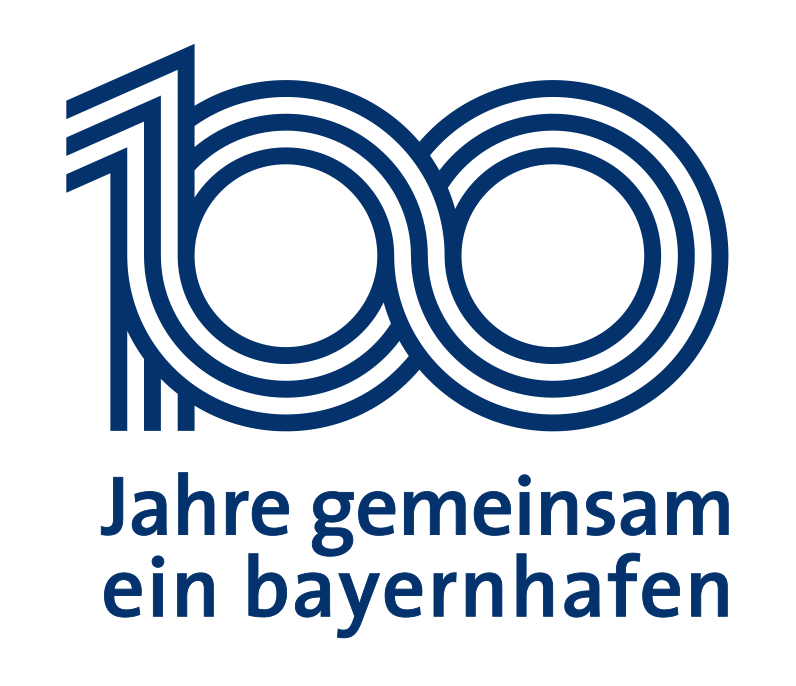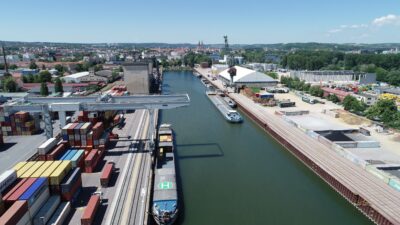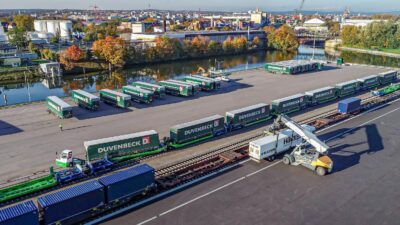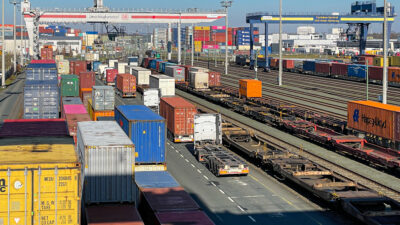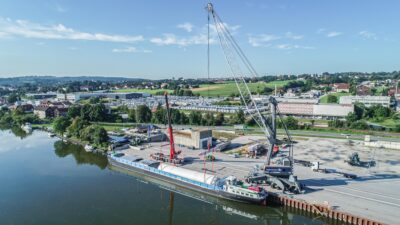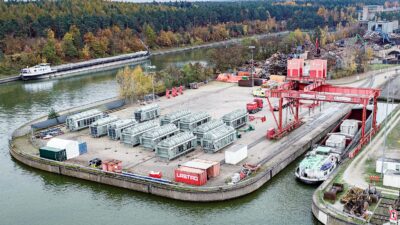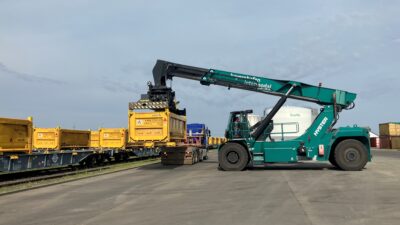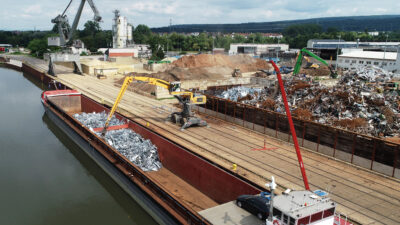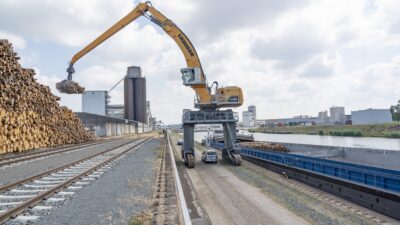13 March 2025 | bayernhafen
Proof positive of the potential of inland ports
2024 financial year: 8.17 million tons of goods handled by inland waterway and rail, 474,030 TEU in combined transport, 475,000 HGV trips saved
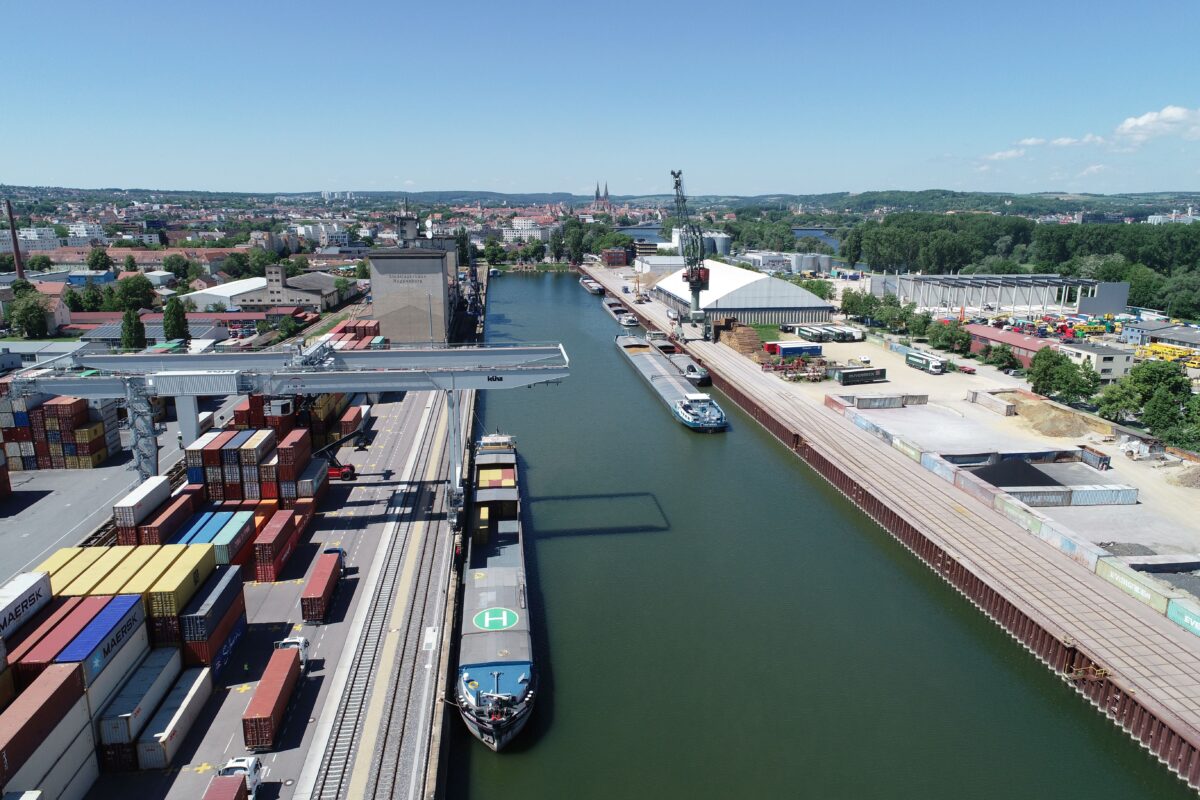
The combined rail and inland waterway cargo throughput at bayernhafen amounted to 8.17 million tons in 2024. By shifting long-distance transport to the more environmentally friendly modes of inland waterway and rail, approximately 475,000 HGV trips were avoided. Bayernhafen comprises six locations: Aschaffenburg, Bamberg, Nuremberg, Roth, Passau, and Regensburg (pictured here). (Image source: bayernhafen / Michael Ziegler)
Regensburg, 13 March 2025 – In 2024, bayernhafen transported 8.17 million tonnes of goods via inland waterway and rail across its six locations in Aschaffenburg, Bamberg, Nuremberg, Roth, Regensburg, and Passau. This represents a 0.8% decline from the previous year, marking the third consecutive year of decreasing volumes. The downturn in the German economy and ongoing economic challenges are also reflected in the port handling figures. “Ports are always a reflection of developments in industry and in the wider economy,” says Joachim Zimmermann, Chief Executive Officer of bayernhafen. “For the most part, we have managed to counter this negative trend, particularly through new combined transport routes, demonstrating the potential of inland ports to deliver sustainable logistics chains.” In 2024, around 475,000 HGV trips were avoided by shifting long-distance transport to the more environmentally friendly modes of inland waterway and rail.
The volume of goods transported by inland waterway totalled 2.06 million tonnes, a 6.6% decline from 2023. This decrease was exacerbated by a number of conditions, including the closure of a paper mill near bayernhafen Aschaffenburg that impacted negatively on the transportation of fuel and raw materials. Rail freight throughput, on the other hand, increased by 1.3% to 6.1 million tonnes. Combined transport (CT) throughput across all bayernhafen locations reached 474,030 TEU (1 TEU equals a 20-foot standard container), representing a 4.7% increase compared to the previous year. In addition to containers used in seaport-hinterland traffic, this also includes swap bodies and semi-trailers deployed in continental transport, the proportion of which experienced significant growth last year.
Ports are always a reflection of developments in industry and in the wider economy.
Joachim Zimmermann
Chief Executive Officer of bayernhafen
Investment in the Regensburg trailer port, a terminal specifically designed for transferring swap bodies and semi-trailers from road to rail, facilitated the launch of new transport services to Lébény in Hungary and Verona in Italy via the Brenner Pass. These routes utilise the new Helrom trailer wagon, which enables horizontal loading of truck trailers onto rail.
In 2024, bayernhafen committed approximately €32 million to port infrastructure and land development across all its locations. Some of these projects span multiple years, such as the modernisation of the East Port North Quay in Regensburg. In addition, customers continue to invest in all bayernhafen ports. Rödl, for instance, is planning an ‘Energy Port’ in Nuremberg, which will provide all commonly used energy forms, including a hydrogen refuelling station. The project has received a subsidy certificate from the Free State of Bavaria.
bayernhafen’s locations are logistics hubs, job drivers, and the number one transfer zone in Bavaria.
Joachim Zimmermann
Chief Executive Officer of bayernhafen
Home to over 400 companies, the six bayernhafen locations serve as logistics hubs, ensuring the reliable supply of domestic products to the public and industry. As key transport interfaces and gateways to global markets, they efficiently connect road, rail, and inland waterways, facilitating sustainable logistics chains.
“A fully functional and efficient transport network is essential, yet there is a pressing need for modernisation, particularly in the rail network and infrastructure such as locks and bridges in Germany,” explains Joachim Zimmermann, Chief Executive Officer of bayernhafen. “Due to the planned months-long full closures of the railway lines to Regensburg and Passau in 2026 as part of the general modernisation concept, we and our customers expect significant impacts.” Given the current economic challenges, Zimmermann, who also serves as President of the Federal Association of Public Inland Ports (Bundesverband Öffentlicher Binnenhäfen e. V.), calls for stable policy frameworks and enhanced competitiveness through reduced bureaucracy and expedited approval processes.
bayernhafen Celebrates Centenary in 2025
One hundred years ago, on 27 August 1925, the Free State of Bavaria laid the foundation for the success of the state-owned ports by establishing port authorities, later consolidated under the ‘Bavarian State Port Administration’. In 2005, the State Port Administration transitioned into Bayernhafen GmbH & Co. KG, with the Free State of Bavaria as the sole shareholder.
Creativity remains a crucial success factor today. “We have always used our entrepreneurial freedom to actively shape our success. The bayernhafen locations are logistics hubs, job drivers, and the number one transfer zone in Bavaria,” says Joachim Zimmermann. “We continuously invest in infrastructure and land development while working with our customers to unlock new potential for added value.” bayernhafen sees its role as a ‘location architect’, developing inter-company and cross-location strategies. Through strategic land management, including optimisation, revitalisation, and conversion, bayernhafen ensures companies have continuous access to new sites. Working in partnership with stakeholders, bayernhafen has firmly established combined transport at its locations, laying the groundwork for further development.

